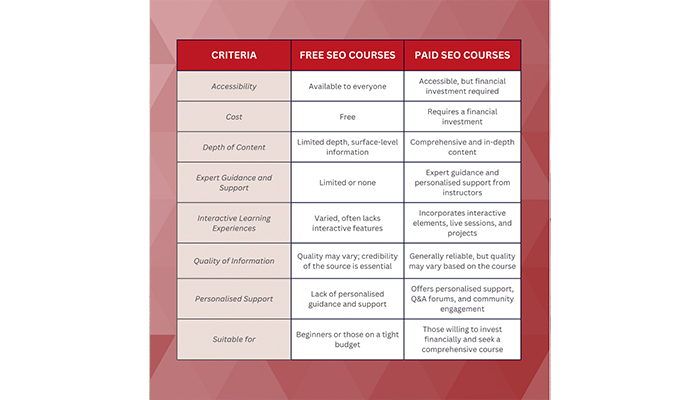I. Introduction
SEO is essential for online success. As businesses and individuals seek to enhance their online presence, the demand for SEO training has surged. A crucial decision often faced by aspiring SEO professionals is whether to opt for free or paid SEO courses. We discuss the advantages and limitations of both options, offering insights to help you make an informed choice.
II. Free SEO Courses
A. Advantages
Accessibility to Everyone
Free SEO courses break down financial barriers, making valuable knowledge accessible to a broader audience. Individuals with limited budgets or those exploring SEO as a hobby can benefit from these readily available resources.
Cost-Effective
The allure of free SEO courses lies in their cost-effectiveness. Learners can acquire fundamental SEO skills without spending a penny. It makes it an attractive option for those who are budget-conscious or unsure about committing to a paid course.
A Diverse Range of Topics Available
Free courses often cover a wide array of SEO topics. This diversity enables learners to explore different aspects of SEO and gain a broad understanding of the field.
B. Limitations

Quality May Vary
The quality of free SEO courses can be inconsistent. While some platforms offer reliable information, others may lack accuracy or fail to keep pace with industry updates. It becomes imperative for learners to discern the credibility of the source.
Limited Depth of Information
Free courses typically provide surface-level knowledge. Learners seeking in-depth insights into advanced SEO techniques may find these courses insufficient. The lack of depth can hinder one’s ability to implement strategies effectively.
Lack of Personalised Guidance and Support
Free courses often lack the personalised attention and support that paid alternatives provide. Learners may struggle to navigate challenges without direct guidance, hindering their overall learning experience.
DISCOVER: How To Make A Career Switch In Singapore
III. Paid SEO Courses
A. Advantages
Comprehensive and In-Depth Content
Paid SEO courses can offer comprehensive and in-depth knowledge. They often cover advanced concepts, strategies, and industry best practices, providing a more thorough understanding of SEO.
Expert Guidance and Support
Enrolling in a paid SEO course often means access to expert guidance and support. Instructors with real-world experience can provide valuable insights, answer queries, and offer personalised advice, enhancing the learning process.
Interactive Learning Experiences
Paid courses frequently incorporate interactive elements such as live sessions, Q&A forums, and hands-on projects. These features contribute to a more engaging and effective learning experience, allowing learners to apply their knowledge in real-world scenarios.
B. Limitations
Financial Investment Required
The primary drawback of paid SEO courses is the financial investment required. While the value often justifies the cost, this may pose a barrier for individuals on a tight budget.
Not Accessible to Everyone
Paid courses may exclude individuals who cannot afford the associated costs, limiting the accessibility of valuable SEO training to a demographic like a particular age group or specific location area.
Quality May Vary Based on the Course
Not all paid courses are created equal. Quality can vary based on the course provider, instructor, and curriculum. It is crucial to thoroughly research and choose a reputable course to ensure a return on investment.
IV. 5 Factors to Consider When Choosing Between Free and Paid SEO Courses
A. Individual Learning Preferences
Consider your preferred learning style – whether you thrive in a structured, interactive environment or prefer self-paced learning.
B. Budget Considerations
Evaluate your budget constraints and determine the maximum investment you can allocate to SEO training.
C. Time Commitment
Consider your available time for learning SEO. Paid courses, especially those with interactions, may require more time.
D. Level of Expertise and Experience
Tailor your choice based on your current expertise level. Beginners might find free courses beneficial, while experienced professionals may require the depth offered by paid alternatives.
E. Desired Depth of Knowledge
Define your learning objectives. A paid course may be more suitable if you seek a comprehensive understanding of SEO.
V. 7 Tips for Making the Right Choice
A. Research the Credibility of the Course Provider
Investigate the reputation of the course provider, ensuring they have a track record of delivering reliable and up-to-date content.
B. Read Reviews and Testimonials
Seek feedback from past learners. Others’ feedback can tell you if the course is good or not.
C. Assess the Course Content and Curriculum
Examine the curriculum to ensure it aligns with your learning goals. Look for courses that cover a range of topics relevant to your needs.
D. Evaluate the Level of Support and Community Engagement
Consider the level of support provided, including access to instructors and community forums. Having good support makes learning much better.
E. Consider Trial or Sample Lessons If Available
Some paid courses offer trial periods or sample lessons. Take advantage of these opportunities to assess whether the SEO course meets your expectations before committing financially.
F. Check for Industry Recognition and Accreditation
Look for courses that are recognised by industry authorities because they add credibility to your certification, and you are learning from a reputable source.
G. Assess the Flexibility of Learning Resources
Consider the flexibility of learning resources. Courses that offer a variety of formats, such as video lectures, written materials, and interactive assignments, cater to different learning styles and enhance the overall educational experience.
H. Investigate Alumni Success Stories
Check out stories from people who took the course before. It can help you see how they used what they learned and how it affected their careers.
VI. Conclusion
Free courses offer accessibility and cost-effectiveness, while paid alternatives provide comprehensive content, expert guidance, and interactive learning experiences. By carefully weighing the advantages and limitations of each option, considering personal factors, and following the provided tips, aspiring SEO professionals can make an informed decision that aligns with their goals and aspirations.
Whether free or paid, investing in SEO education is a pivotal step towards mastering the intricacies of digital marketing in today’s competitive online landscape. Contact OOm if you want to relieve yourself from the trouble of self-learning—let the experts teach you the way!

